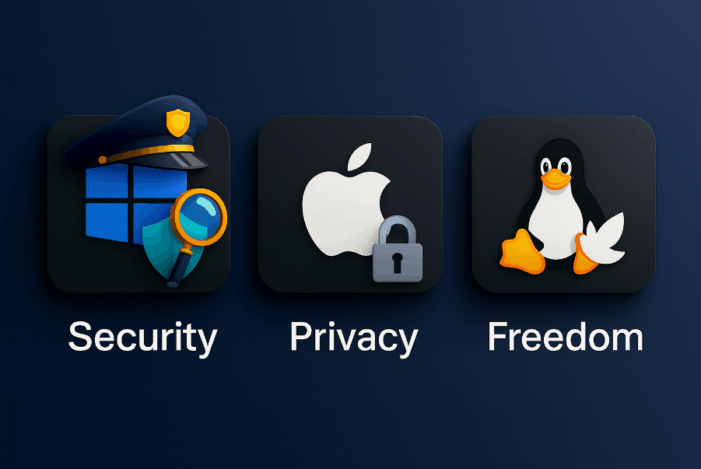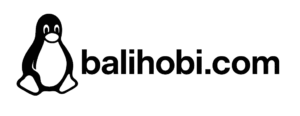Corporate Data Security: Why Open-Source Linux Makes Sense in Business
Corporate know-how is among the most valuable assets. This text briefly and factually summarizes the differences in data collection and privacy management between Windows and Linux, so you can choose a platform with risks and compliance in mind.
What’s Fair to Say About Windows
- Windows sends diagnostic data (telemetry); in corporate environments, their scope and flow can be managed by policies and Microsoft tools. The goal is product improvement and bug fixing. (Official documentation below.)
- Microsoft account requirement: Windows 11 Home and Windows 11 Pro for personal use require internet and a Microsoft account login during initial setup. (Enterprise editions managed by IT are typically deployed differently.)
- Recall on Copilot+ PCs is an optional feature that stores local screen snapshots for later search. Microsoft states local processing, encryption, and control via Windows Hello; however, if the machine is compromised, historical snapshots may represent a sensitive source of data. (The security community has repeatedly pointed this out.)
Why Companies Often Choose Linux and Open Source
- Less implicit data collection by default: in major distributions, system telemetry is usually not enabled at all or opt-in/opt-out, with transparent description (e.g. Ubuntu
ubuntu-reportis configurable; Debian’spopularity-contestis voluntary; Linux Mint states the OS itself does not collect telemetry). - Code transparency: open source enables independent audits and rapid vulnerability fixes.
- Granular control over encryption, sandboxes, and policies (AppArmor/SELinux), without requiring a vendor account in the base OS.
Practical Recommendations (Briefly)
- Default encryption (LUKS/TPM on laptops and desktops) and strong admin authentication.
- Restricted access policies (principle of least privilege, application sandboxing, regular updates from trusted repositories).
- Centralized management (e.g. Ansible/Salt) and user training on handling sensitive data.
Bottom line: Windows offers the comfort of an ecosystem and central tools, but also brings mandatory diagnostics and (for common editions) account login. Linux and open source provide companies with greater control over data, less implicit telemetry, and an auditable foundation for building a secure environment around corporate know-how.
Note: This text is a factual comparison and is not legal advice. Before making major changes to your IT environment, consider consulting a lawyer and security specialist.
Verifiable Sources
- Windows – diagnostic data (telemetry) and corporate management:
Configure Windows diagnostic data in your organization,
Optional diagnostic data,
Required diagnostic events & fields (Windows 11). - Windows 11 – internet and Microsoft account requirement during initial setup (Home, Pro for personal use):
Windows 11 specifications,
Windows 11 requirements. - Recall (Microsoft) – privacy, local storage and control:
Privacy & control over your Recall experience,
Retrace your steps with Recall,
Recall security & privacy architecture (Windows Blog). - Recall – security context and critical perspectives:
Kevin Beaumont: Testing the security & privacy implications,
Malwarebytes: Recall snapshots and TotalRecall. - Linux – telemetry and transparency:
Debian: popularity-contest (voluntary),
Ubuntu:ubuntu-report(opt-in/opt-out, shows data before sending),
Linux Mint: Privacy & Cookies (emphasis on minimal data collection),
Linux Mint (official discussion): “Mint does not collect any telemetry”.

In recent years, more and more questions and complaints have appeared in online discussions, media, and user forums about how popular operating systems are evolving in terms of security and user freedom. This article summarizes the most frequently mentioned points based on publicly available sources and user experiences.
Windows – the most widespread, but often under scrutiny
Windows remains the most widely used desktop system.
Advantages: broad hardware compatibility, a huge selection of software, strong support for business applications.
Disadvantages reported by users: telemetry (data collection), enforced Microsoft account login, inability to easily remove some apps, concerns about new features such as Recall.
Recall feature in Windows 11 – Allows searching through the history of screen snapshots. Some experts have warned that these may contain sensitive data, sparking debate about data security.
(Source: TechRadar – Windows 11 Recall concerns)
Data collection and privacy – Windows includes telemetry features that collect diagnostic data. Microsoft states these data are used to improve the system and fix issues.
However, some users and organizations point out that: even in limited telemetry mode, information about computer configuration and applications is sent, and newer Windows editions often require logging into a Microsoft account, meaning additional data sharing.
(Source: ZDNet – Windows 11 telemetry explained)
Apple macOS – security and privacy vs. closed ecosystem
Apple has long built its image on emphasizing privacy and security.
Advantages:
- Long-term support for older devices.
- Limited ad tracking (e.g., App Tracking Transparency on iOS).
- Integrated hardware and software for higher stability.
Disadvantages reported by users:
- Closed ecosystem – apps are mainly installed from the App Store; outside it, on iOS, it is practically impossible (without so-called jailbreak).
- Limited compatibility – macOS officially runs only on Apple devices.
- Higher purchase cost of hardware.
(Source: Wired – The Pros and Cons of Apple’s Walled Garden)
Linux – openness and freedom of choice
Linux is an open-source system developed by the community as well as companies.
Advantages:
- Free of charge, no account registration required.
- Ability to customize the system to individual needs.
- Wide variety of distributions – from simple (Ubuntu, Linux Mint) to professional (Fedora, Arch).
- Open code – transparency and the ability to audit.
Disadvantages:
- Less support for some commercial applications (although this is improving thanks to tools like Wine or Flatpak).
- Requires some level of technical skill for advanced customization.
(Source: Linux.com – Why choose Linux)
Comparison of approaches
| Feature | Windows | Apple macOS | Linux |
|---|---|---|---|
| Price | Paid (often included in PC price) | Paid (included in Mac devices) | Free |
| System openness | Limited | Very limited | Very high |
| Privacy | Telemetry, cloud services | Limited tracking, but closed | Maximum user control |
| Security | Depends on updates | Strong built-in protections | Depends on user configuration |
| Software support | Largest offering | Very good within ecosystem | Good, but sometimes limited |
Each system has its strengths and weaknesses.
- Windows offers compatibility and convenience, but with greater data collection and fewer customization options.
- Apple macOS emphasizes security and integration, but at the cost of closedness and higher price.
- Linux provides maximum freedom and control, but requires willingness from the user to learn and experiment with new things.
If your main priority is freedom and control over your own computer, Linux is a strong alternative worth trying.

